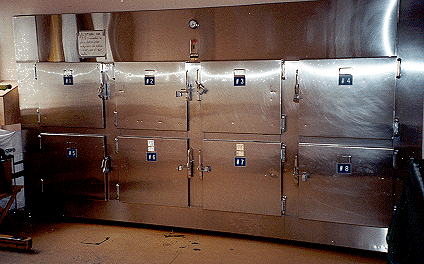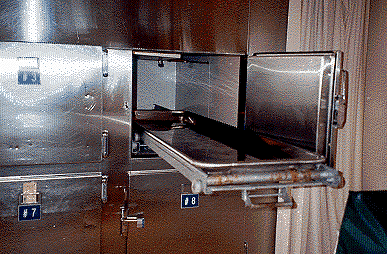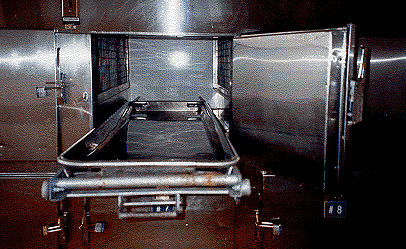Anatomic Pathology
The Cadaver Keep
Unrefrigerated bodies decompose, so every morgue
has a place where the deceased are kept cold until and after they have been autopsied.

This is the forensic-type refrigeration unit of a small community hospital, with individual end-opening storage chambers for up to 8 bodies. A coroner's department in a large city would have many more chambers than this. The doors are numbered, and have a slot in which a copy of the "toe tag" can be put, identifying who is inside. The handle of each door can be padlocked to prevent evidence tampering before the autopsy. Some hospitals use a single walk-in refrigerated room as a morgue, with bodies placed on individual gurneys (beds with wheels).
Waiting can result from any of several reasons:
- Somebody dies after regular office hours. Except for special circumstances, hospital autopsies are performed only during office hours -- otherwise everybody would have to be paid overtime wages.
- More than one body needs to be autopsied. In most hospital pathology departments, the duty rota is such that only one pathologist performs the autopsies for a given day. Cases are done one at a time, and the bodies next in line chill out until their turn to be wheeled to the autopsy suite. Generally it is "first come, first served", but if a body is needed urgently for a funeral, the order can be switched.
- The body awaits autopsy consent. Sometimes the next of kin are not present at the moment of death, so obtaining consent for a postmortem examination gets delayed until they come to the hospital to sign the consent form, or call the hospital to give witnessed consent over the telephone. Performing an autopsy on a body without the consent of the deceased's next of kin (or a coroner's warrant) is considered assault in the eyes of the law. Pathologists would rather not go to jail, so until the consent paperwork is in order, they let the body cool its heels.
- The body awaits pickup. After an autopsy is completed, a call is placed to the body's next stop. A hearse comes to take the deceased to the funeral home, where the undertaker works his/her wonders before the funeral.

At the hospital where these images were taken, the morgue is at the back of the hospital on the ground floor, and this body storage area is closest to the outside, more convenient for undertakers, who can simply pull up to the door in their hearses. At other hospitals, they might have to park the hearse, then take an elevator up or down to get the body they have come for.

The only living people who spend any significant amount of time in this part of the morgue are porters, who bring the bodies from the hospital ward, pathologist assistants, who bring the bodies to and from the autopsy suite, and undertakers, who take the bodies to the funeral home.
| Questions? Suggestions? |
